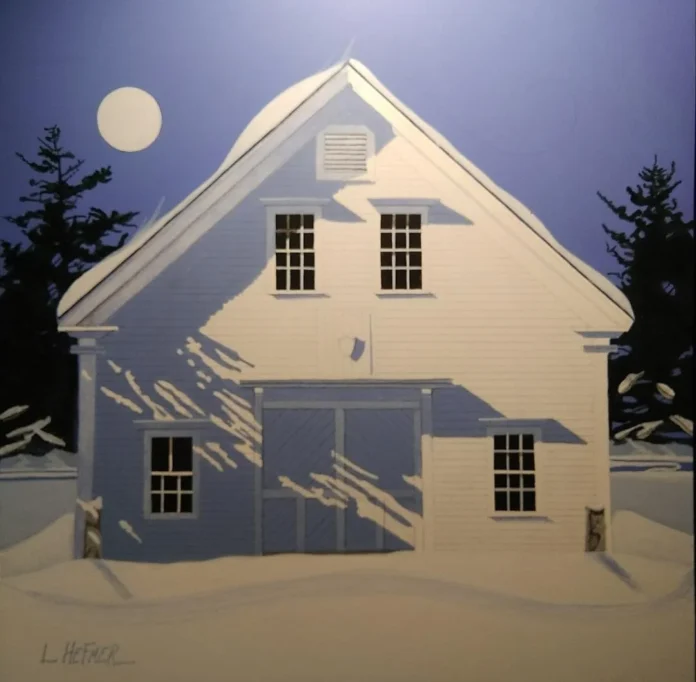Linda Hefner’s art stands as a vibrant bridge between the past and the present, a visual testament to the beauty, endurance, and quiet dignity of New England’s historic architecture. Known for her luminous acrylic paintings of barns, schoolhouses, and other rural landmarks, Hefner captures the vanishing essence of a landscape that once defined the American spirit. Her work is more than nostalgic; it is a form of preservation, an act of reverence for craftsmanship, community, and continuity.
Growing up in rural Maine, Hefner spent her childhood surrounded by one-room schoolhouses and pre-Civil War barns near her father’s mink farm. These structures were more than scenery; they were integral to the rhythm of daily life, embodying the resilience and resourcefulness of the people who built them. This early exposure laid the foundation for a lifelong fascination with what she calls endangered Americana. Her connection to these buildings, their timbers, textures, and quiet endurance, continues to inspire her meticulous artistic practice.
From Illustration to Fine Art
Though Hefner’s career began in illustration, with her work appearing in The New Yorker and Harper’s Bazaar, her current paintings reflect a deliberate shift away from the fast-paced, ephemeral world of commercial imagery. Her fine art practice is a conscious slowing down, a meditation on permanence in a culture increasingly driven by speed and consumption.
Each painting begins with extensive research and multiple site visits. Hefner takes the time to observe her subjects in various lights and seasons, waiting for the moment when a building reveals its mute and elusive personality. She paints on prepared birch panels sanded to an eggshell finish, allowing for both precision and luminosity. Every brushstroke speaks to her reverence for accuracy and patience as she reconstructs the architectural forms with the care of a restorer breathing life into history.
The Emotional Architecture of a Vanishing World
Hefner’s fascination with her subjects is deeply emotional. Her paintings, while grounded in realism, are imbued with a spiritual quality, a sense that these old buildings still hold stories and secrets. She has said that they were made before electricity, before antibiotics, by people who needed these places in order to survive as communities. To her, they are beautiful and cannot be forgotten.
This sentiment runs through her body of work: each barn and schoolhouse she paints stands as both artifact and symbol. To Hefner, they represent the strength of collective purpose and the endurance of human hands working in harmony with nature. Her paintings invite viewers to reflect on what has been lost, not just buildings, but ways of living that valued care, cooperation, and craftsmanship.
A Visual Language of Light and Time
Light plays a central role in Hefner’s paintings. Whether it is the warm glow of dusk falling over weathered clapboards or the silvery blue of moonlight on a snow-covered roof, light in her work becomes a narrative device, revealing the emotional timbre of her subjects. She balances accuracy with atmosphere, creating scenes that feel both deeply real and quietly poetic.
Her 2022 work, “Night in New England”, exemplifies this delicate balance. Painted in acrylic on panel, the piece captures the haunting stillness of a rural night, a barn bathed in moonlight, its timeworn wood glowing softly against a deep indigo sky. The viewer can almost sense the crisp chill of the air, the silence stretching across the fields. It is not merely a painting of a building, but a portrait of endurance, solitude, and remembrance.
Technique and Devotion
Hefner’s technique reflects her devotion to both craft and subject. Her choice of birch panels allows her to achieve fine detail and depth of tone, while her acrylic medium provides the clarity and vibrancy necessary to evoke the texture of aged wood, stone, and sunlight. She works slowly and deliberately, building up layers of color and light until the surface breathes with quiet vitality.
This patience mirrors the values of the very people who built her subjects. Each brushstroke, each detail, becomes a small act of preservation, a way of keeping alive the handmade integrity of America’s rural past. Through this process, Hefner transforms architectural documentation into lyrical storytelling.
A Call to Remember
In an age where progress often means demolition and replacement, Linda Hefner’s art stands as a counterpoint, a reminder that beauty and meaning often reside in what we are quick to discard. Her paintings encourage us to pause, to look closer, and to remember the generations who found sustenance and community within these now-fading walls.
Classic New England architecture, as she notes, is a dying breed. Her work celebrates these structures not as relics, but as living symbols of endurance and grace. Each painting becomes a dialogue between past and present, an invitation to share in the stillness, to honor what remains, and to recognize that even in decay, there is profound beauty.
Conclusion: A Legacy of Light and Memory
Linda Hefner’s paintings are more than visual records; they are acts of devotion. Through her eyes, barns and schoolhouses cease to be forgotten ruins; they become monuments to resilience and memory. Her work preserves the poetry of place, reminding us that the soul of New England still resides in its weathered wood, its quiet fields, and its steadfast structures that have endured the test of time.
In honoring these vanishing forms, Hefner also honors the spirit of those who built them, ensuring that their stories will not fade into shadow but continue to shine with enduring light.


